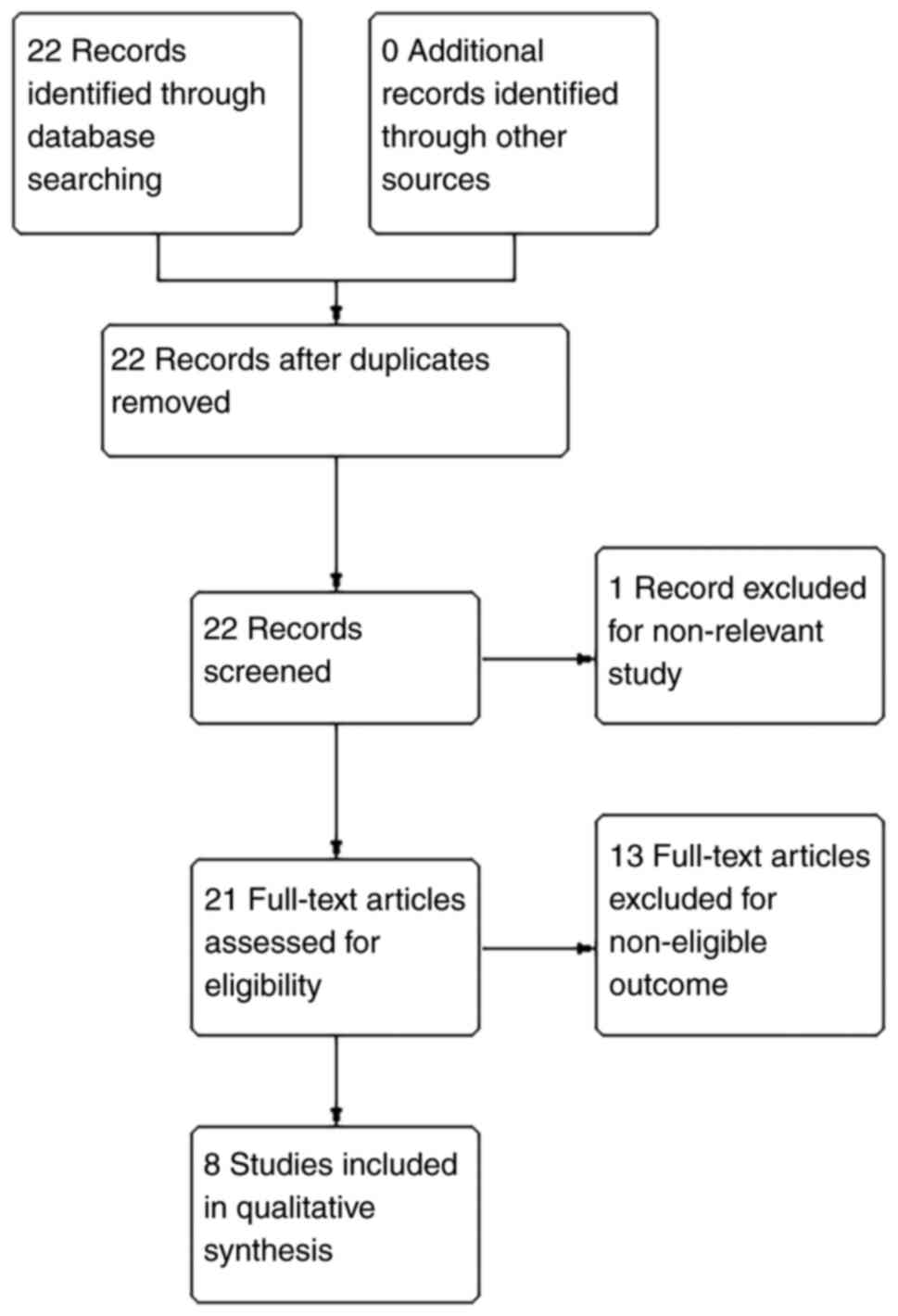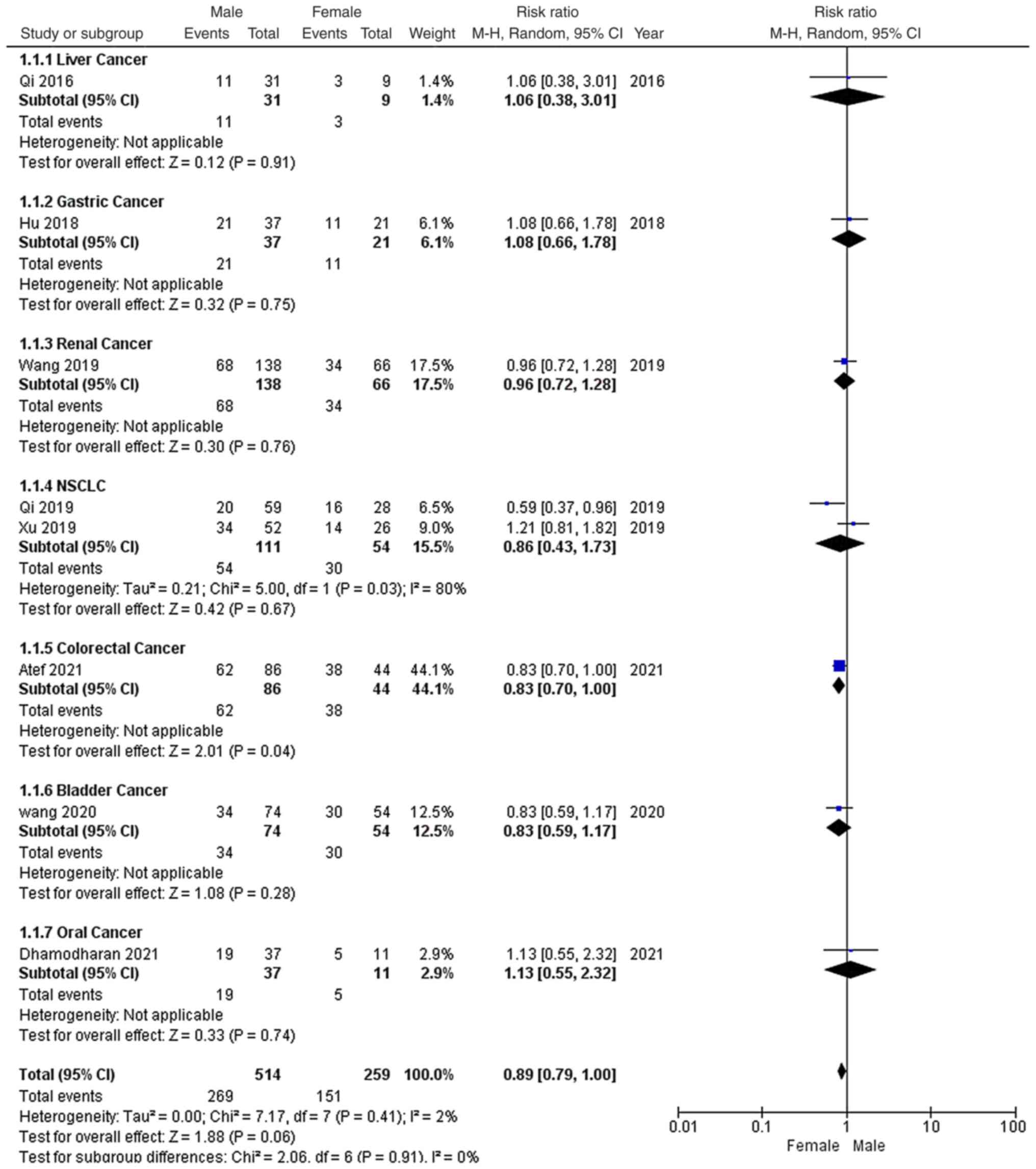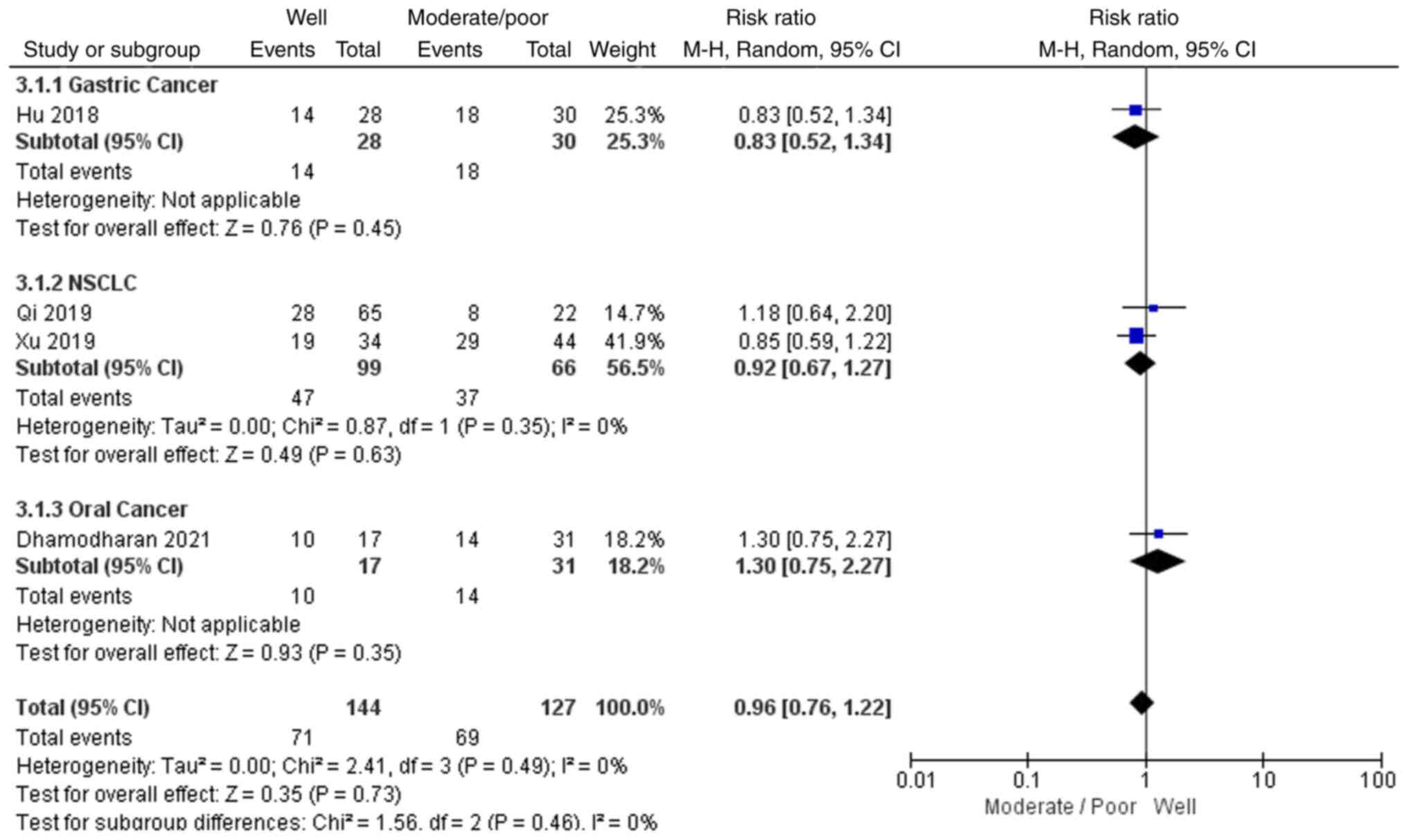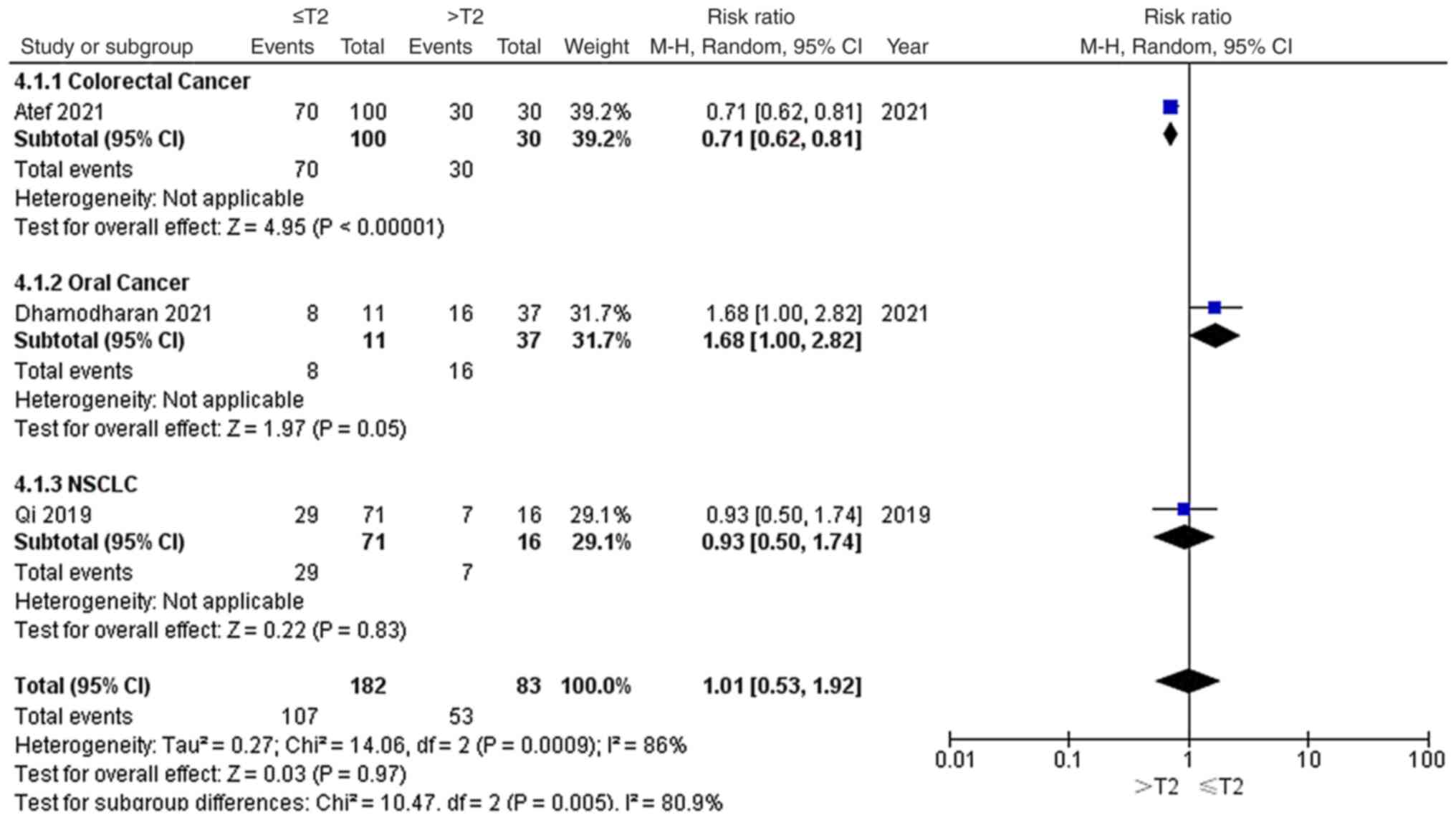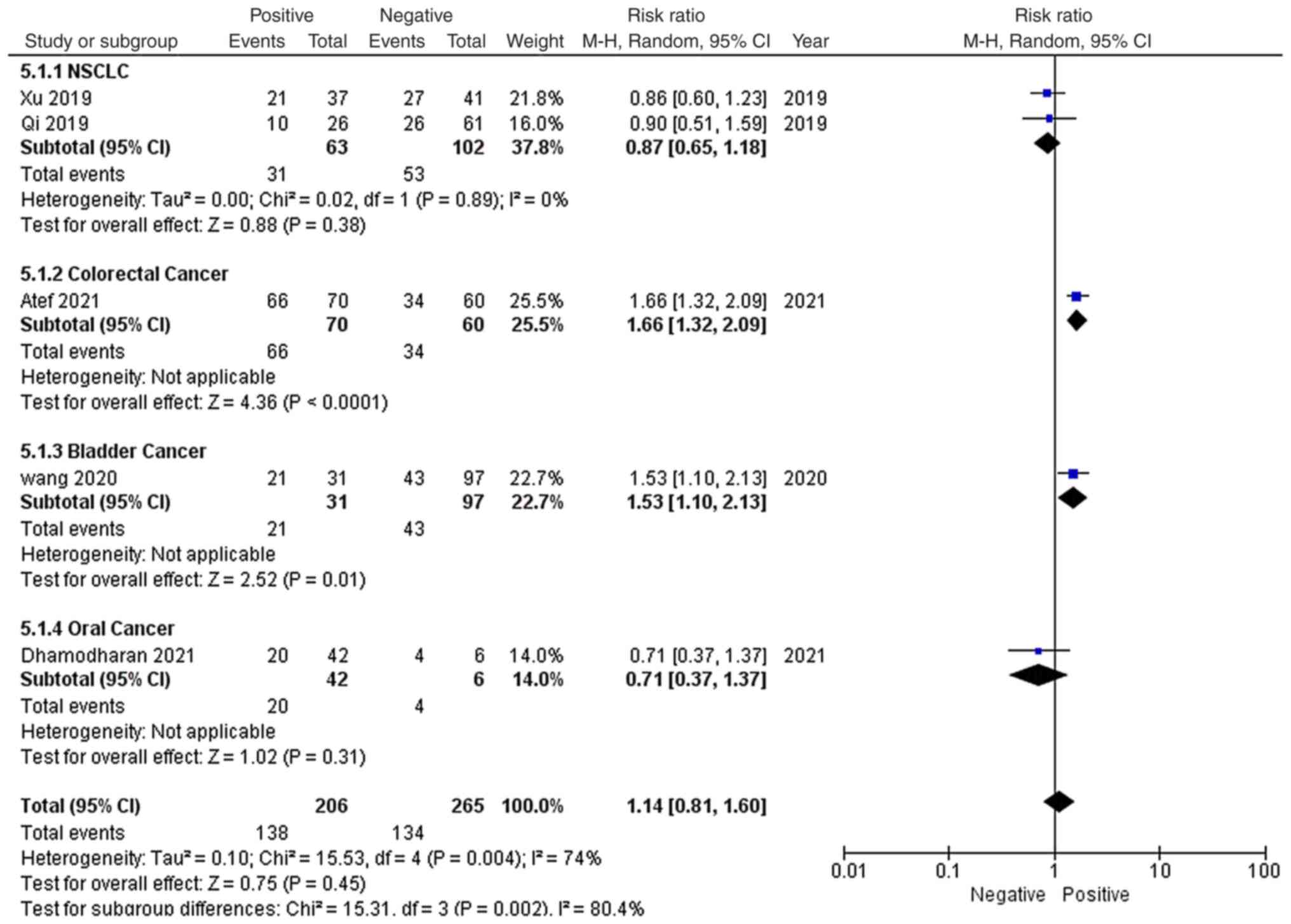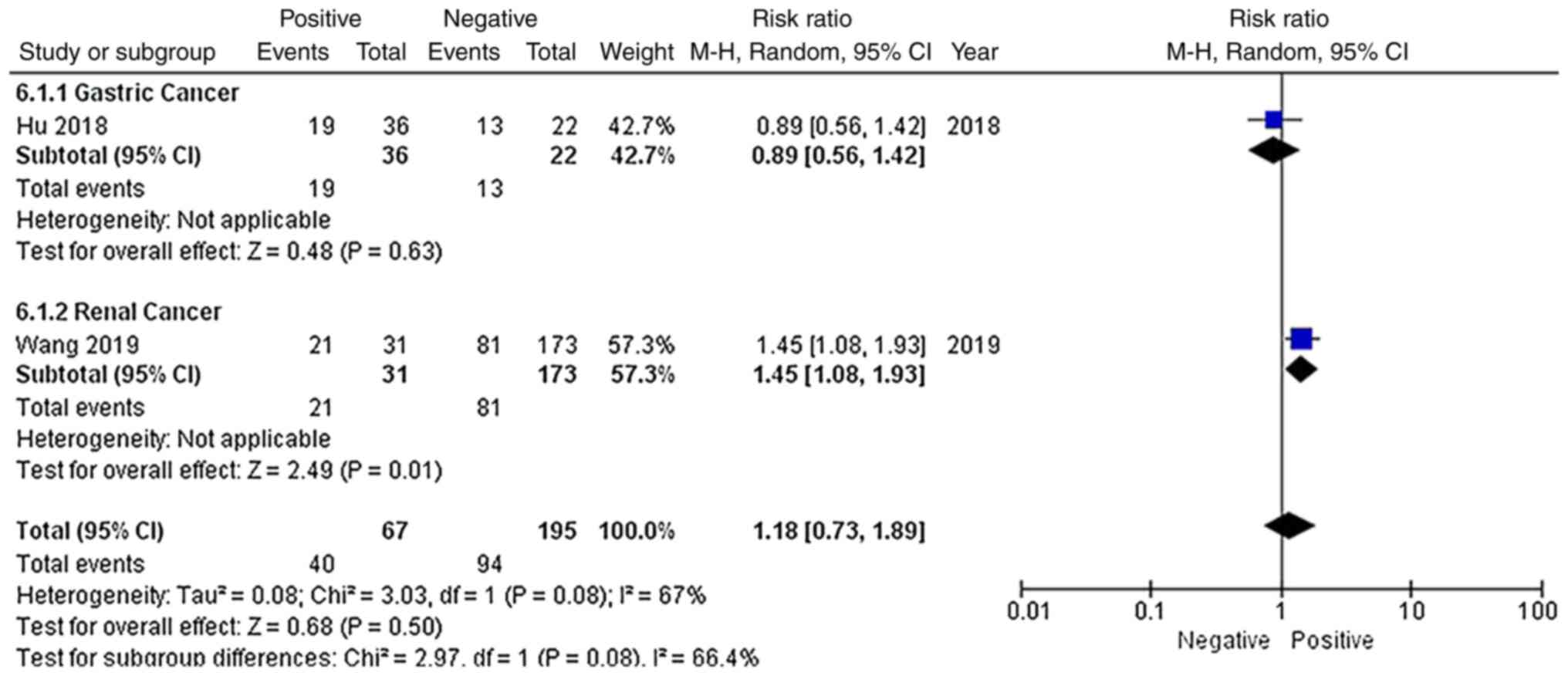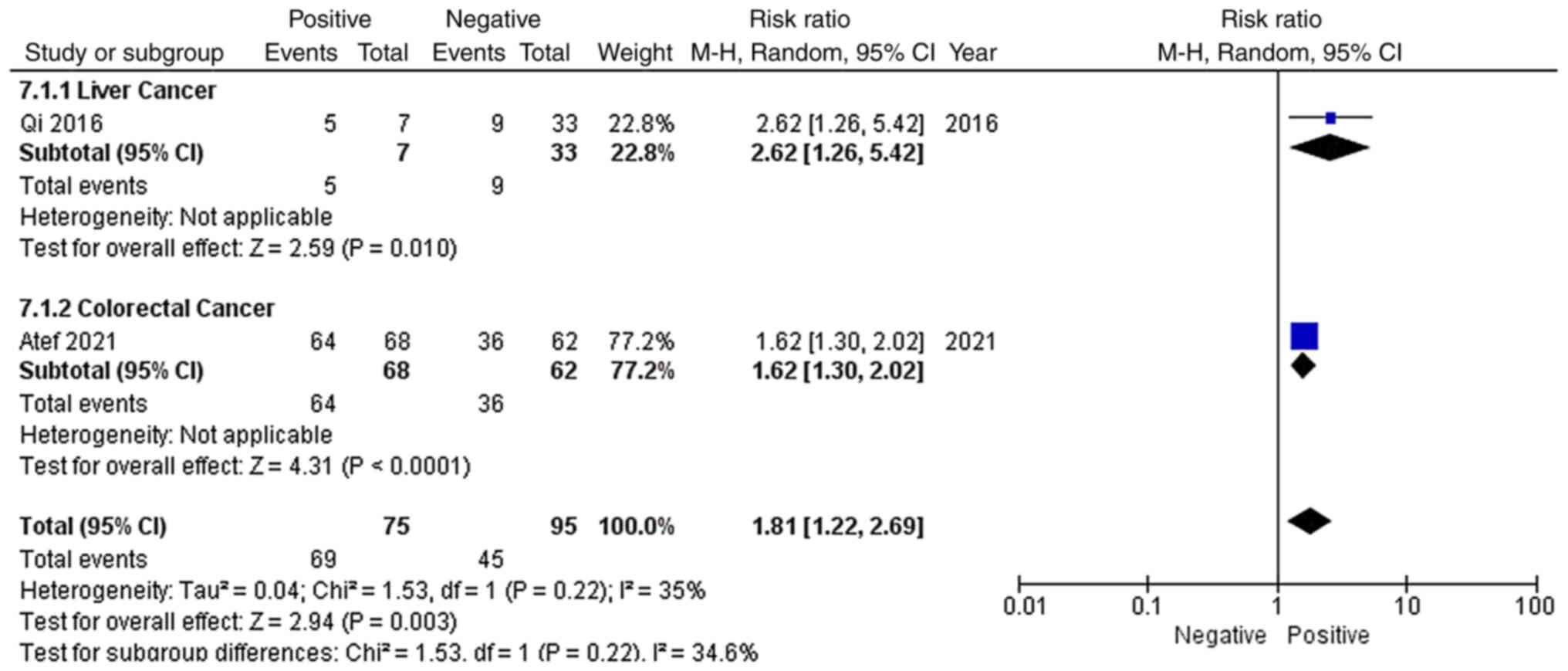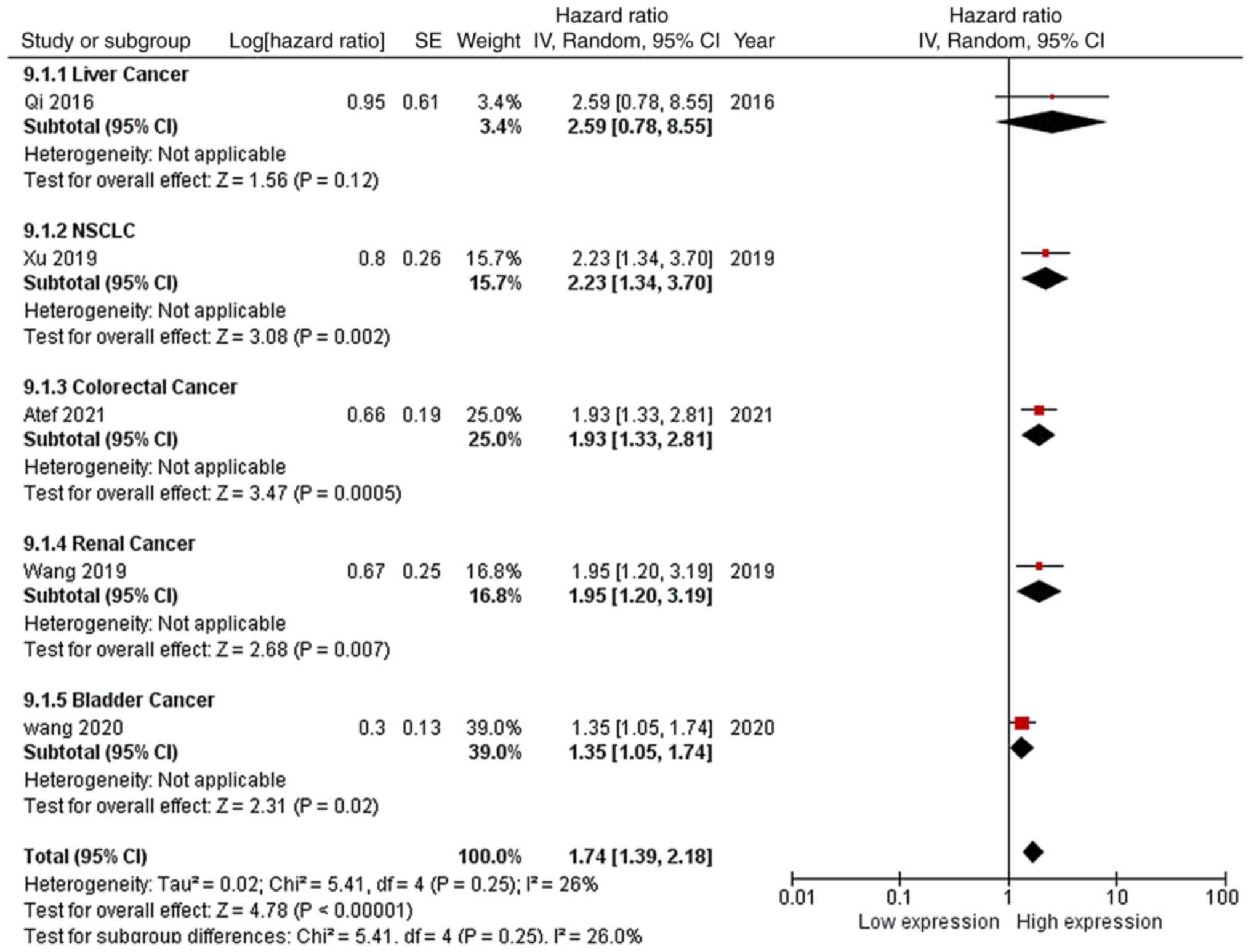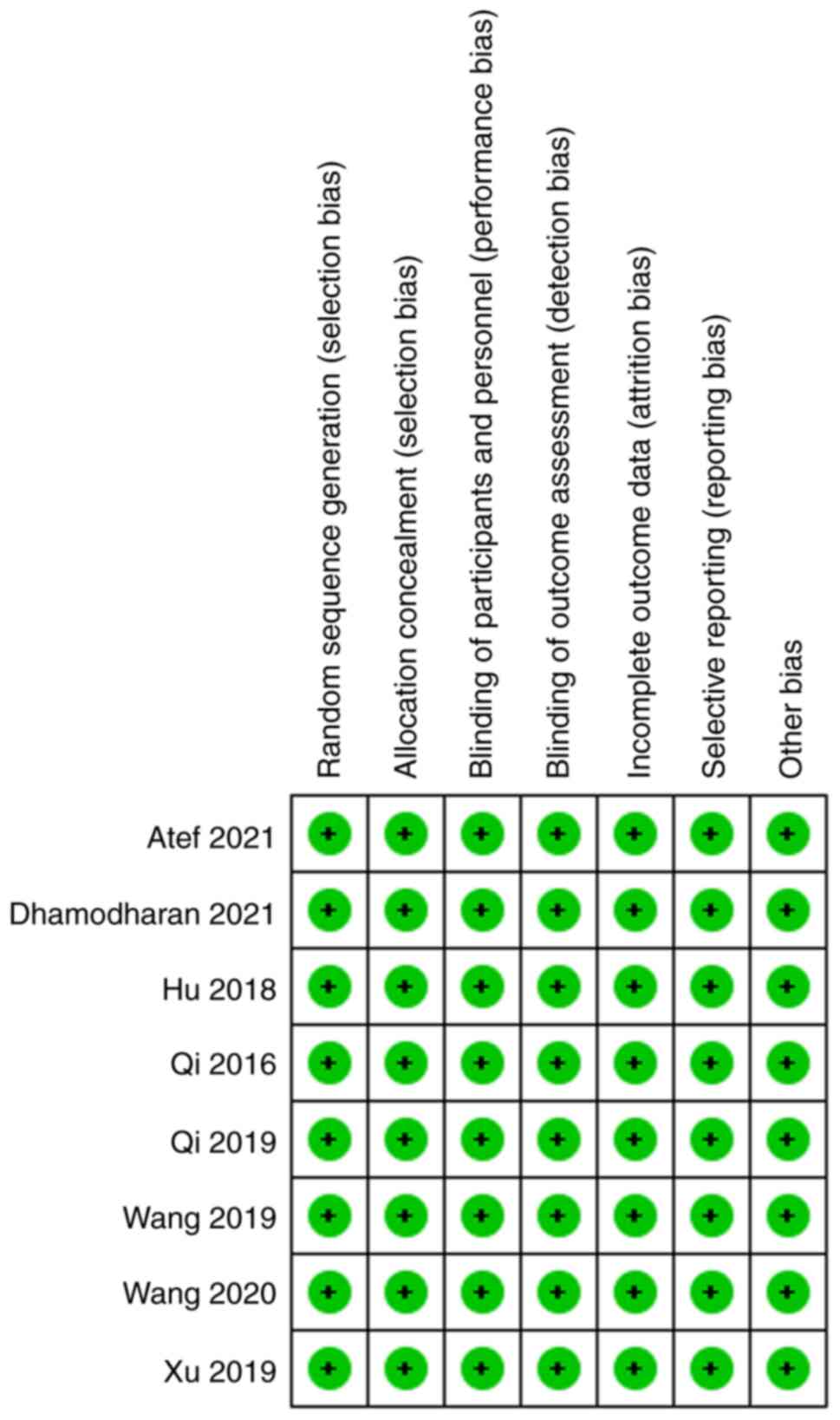Clinical role of the long non‑coding RNA, EGFR‑AS1, in patients with cancer: A systematic review and meta‑analysis
- Authors:
- Published online on: March 8, 2024 https://doi.org/10.3892/ol.2024.14332
- Article Number: 199
-
Copyright: © Zhu et al. This is an open access article distributed under the terms of Creative Commons Attribution License.
Abstract
Introduction
Long non-coding RNAs (lncRNAs) are >200 bp RNAs that do not encode proteins, which have been demonstrated to fully participate in the metabolic processes of cancer cells (1). Compared with RNA-encoding proteins, lncRNAs possess a greater reservoir of transcriptional information (2). EGFR-AS1 is a 2,821-kb lncRNA located on human chromosome 7; its locus is in the opposite direction of EGFR gene transcription according to the UCSC database (http://genome.ucsc.edu/).
Since it was first studied in liver cancer (3), EGFR-AS1 has been comprehensively studied in various solid cancer types including gastric, renal, lung, colorectal, bladder and oral cancer (4–14). Despite its coordination with EGFR to regulate cancer cell metabolism, EGFR-AS1 has also been shown to possess independent regulatory function (15). EGFR-AS1 can also be regulated via epigenetic modulation; it can be activated by K27 acetylation, which suppresses the activation of microRNA (miR)-2355-5p and promotes cervical cancer cell proliferation via the Wnt pathway (16). EGFR-AS1 overexpression was also reported to induce resistance to tyrosine kinase inhibitors in squamous cell carcinoma (14). Therefore, the function of EGFR-AS1 is similar to other oncogenes and influences cancer cell prognosis. The present study was conducted to comprehensively investigate the oncogenic role of EGFR-AS1 in several types of solid tumour.
Materials and methods
Literature search
The articles screened in the present study were identified following an electronic search of the PubMed (https://pubmed.ncbi.nlm.nih.gov/) database using the keywords ‘cancer or carcinoma or neoplasm or tumour’ and ‘long noncoding RNA EGFR-AS1 or noncoding RNA EGFR-AS1 or EGFR-AS1’ by two investigators. These key words were applied in different combinations. The bibliographies from any of the identified studies were used to identify further studies. The screened articles were limited to published studies or to studies where at least the abstract was published in English. No contact was made with the authors of the published studies to obtain unpublished data.
Selection of trials
A total of 22 articles were obtained from March, 2002 to March, 2023. Prior to finalizing the list of candidate articles, several inclusion criteria were determined as follows: i) The research contained at least one of the following clinical characteristics: Patient sex, tumour size, distant metastasis, lymph node metastasis, tumour-node-metastasis (TNM) stage, pathological stage and overall survival (OS); ii) the expression of EGFR-AS1 lncRNA was evaluated in tumour tissues only (not serum or any other tissues) and the method used was reverse transcription-quantitative PCR (RT-qPCR); iii) all analysed samples were extracted from humans; and iv) all patients were divided into groups based on high or low EGFR-AS1 expression.
Data extraction and quality assessment
Two investigators independently extracted the data from each original publication, including the first author's name, the year of publication, the country of origin, the cancer type, the total number of cases, the number of patients in the high and low EGFR-AS1 expression groups, the detection method, the outcome measures and the cut-off value for EGFR-AS1 expression levels. Missing information was estimated according to the Cochrane Handbook (https://china.cochrane.org/zh-hans/resources/cochrane-resources/cochrane-handbook). Discrepancies between the two investigators (for example, whether a certain study should be included) were resolved by discussion and consensus. The quality of the included studies was assessed using the Newcastle-Ottawa Quality Assessment Scale (NOQAS) (17).
Among the 8 included studies, only 5 provided Kaplan-Meier curves and none provided hazard ratios (HRs) and corresponding 95% confidence intervals (CIs), despite constructing survival curves. Using widely proven and accepted scientific methods, the data were extracted from the survival curves using Engauge 4.1 (http://digitizer.sourceforge.net/) (18–20). Subsequently, the extracted data were entered into the HR calculation spreadsheet, which was created by Tierney et al (21). The HRs, standard errors and corresponding 95% CIs were then estimated from the survival curves.
Statistical analysis
Risk ratios (RRs) with 95% CIs were estimated to evaluate the correlation between high expression of EGFR-AS1 lncRNA and the clinical outcomes of patients with cancer. The cancer samples were classified into well-differentiated and moderately/poorly differentiated according to their reported differentiation grade status. According to the information provided in each study, the tumour stageswere separated into two groups, namely ≤T2 (early stage) and >T2 (advanced stage); the TNM stage was divided into two groups, namely early stage (I–II) and advanced stage (III–IV). Distant metastasis, lymph node metastasis and vascular invasion were divided into ‘positive’ and ‘negative’ groups. All the extracted data were pooled using Review Manager 5.3 (The Cochrane Collaboration). According to the recommendations provided by the Cochrane Handbook (https://training.cochrane.org/handbook/current/chapter-10#section-10-10-4-1), a random-effects model was used to analyse the pooled results in the present study.
Results
Characteristics of the included trials
As shown in Fig. 1, 8 of the 22 identified studies completely fulfilled the inclusion criteria of the present systematic review. A total of 14 trials were excluded due to non-relevant study types or outcomes. The included studies covered 7 types of cancer as follows: 1 for liver cancer (3) 1 for gastric cancer (13), 1 for renal cancer (10), 2 for non-small cell lung cancer (NSCLC) (9,11), 1 for colorectal cancer (4), 1 for bladder cancer (6) and 1 for oral cancer (5).
As depicted in Table I, the 8 included trials were from China, Egypt and India. The trials included 773 patients in total, 420 with high ERGR-AS1 expression and 353 with low EGFR-AS1 expression. The EGFR-AS1 expression levels in patients were all evaluated by RT-qPCR analysis. In total, 4 studies applied relative expression between cancer and adjacent normal samples as the cut-off, 2 studies applied median expression and 1 study applied 1.85 (the median mRNA expression) as the cut-off for grouping.
As shown in Table II, the NOQAS scores of the included studies were not <7 points, indicating that the quality of the included studies was relatively high, laying a solid foundation for the conclusions drawn in the present study.
Association between EGFR-AS1 expression level and the general characteristics of patients with cancer
As shown in Fig. 2, all the studies reported the sex distribution of the included patients. Among the 773 patients, there were 514 males and 259 females. Furthermore, 269 male and 151 female patients had high EGFR-AS1 expression. Due to low heterogeneity (P=0.41; I2=2%) and the recommendations provided by the Cochrane Handbook, a random-effects model was applied to evaluate the pooled RR and 95% CI of EGFR-AS1 expression among the sexes. The pooled RR of high EGFR-AS1 expression among males versus females was 0.89 with a 95% CI of 0.79–1.00, which indicated that high EGFR-AS1 expression was not associated with sex among these patients with cancer.
As shown in Fig. 3, among the 8 studies, only 3 studies reported the smoking status of patients, which were 2 NSCLC studies and 1 oral cancer study. A total of 60 smoking and 48 non-smoking patients with high EGFR-AS1 expression were identified out of the 213 patients. Due to high heterogeneity (P=0.02; I2=75%), a random-effects model was applied to evaluate the pooled RR and 95% CI of smoking status and EGFR-AS1 expression. The pooled RR of high EGFR-AS1 expression among smokers versus non-smokers was 0.78 with a 95% CI of 0.46–1.31, which indicated that high EGFR-AS1 expression was not associated with the smoking status of these patients with cancer.
As shown in Fig. 4, 4 out of the 8 studies reported the differentiation grades of the tumour samples, including 1 gastric cancer study, 2 NSCLC studies and 1 oral cancer study. In total, 71 patients with well-differentiated tumours and 69 with moderately or poorly differentiated tumours had high EGFR-AS1 expression. Due to low heterogeneity (P=0.49; I2=0) and the recommendations provided by the Cochrane Handbook, a random-effects model was applied to evaluate the pooled RR and 95% CI of tumour differentiation and EGFR-AS1 expression. The pooled RR of high EGFR-AS1 expression following a comparison of the well-differentiated with the moderately/poorly differentiated groups was 0.96 with a 95% CI of 0.76–1.22, which indicated that high EGFR-AS1 expression was not associated with the differentiation grade for these patients with cancer.
Association between EGFR-AS1 expression level and the clinical stages of patients with cancer
As shown in Fig. 5, 3 out of 8 studies reported the tumour stages of the included patients, including 1 colorectal cancer study, 1 oral cancer study and 1 NSCLC study. Among the 265 patients, 102 patients with ≤T2 stage and 53 patients with >T2 stage had high EGFR-AS1 expression. Due to significant heterogeneity (P=0.0009; I2=86%), a random-effects model was applied to evaluate the pooled RR and 95% CI of tumour grade and EGFR-AS1 expression. The pooled RR of high EGFR-AS1 expression among the different tumour stages was 1.01 with a 95% CI of 0.53–1.92, which indicated that high EGFR-AS1 expression was not associated with tumour stage for these patients with cancer.
As shown in Fig. 6, among the 8 studies, 5 reported the lymph node metastasis status of patients, including 2 NSCLC studies, 1 colorectal cancer study, 1 bladder cancer study and 1 oral cancer study. Among the 471 patients, 138 patients with lymph node metastasis and 134 patients without lymph node metastasis had high EGFR-AS1 expression. Due to significant heterogeneity (P=0.004; I2=74%), a random-effects model was applied to evaluate the pooled RR and 95% CI of lymph node metastasis and high EGFR-AS1 expression. The pooled RR of high EGFR-AS1 expression among the different lymph node metastasis statuses was 1.14 with a 95% CI of 0.81–1.60, which indicated that high EGFR-AS1 expression was not associated with lymph node metastasis for these patients with cancer.
As shown in Fig. 7, only 2 studies reported the distant metastatic status of patients, including 1 gastric cancer study and 1 renal cancer study. Among the 262 patients, 40 patients with distant metastasis and 94 patients without distant metastasis had high EGFR-AS1 expression. Due to significant heterogeneity (P=0.08; I2=67%), a random-effects model was applied to evaluate the pooled RR and 95% CI of distant metastasis and EGFR-AS1 expression. The pooled RR of high EGFR-AS1 expression among the different distant metastatic statuses was 1.18 with a 95% CI of 0.73–1.89, which indicated that high EGFR-AS1 expression was not associated with distant metastasis for these patients with cancer.
As shown in Fig. 8, only 2 studies reported the vascular invasion status of the included patients, including 1 liver cancer study and 1 colorectal cancer study. Among the 170 patients, 69 patients with vascular invasion and 45 patients without vascular invasion had high EGFR-AS 1 expression. Due to low heterogeneity (P=0.22; I2=35%) and the recommendations provided by the Cochrane Handbook, a random-effects model was applied to evaluate the pooled RR and 95% CI of vascular invasion and EGFR-AS 1 expression. The pooled RR of high EGFR-AS1 expression among the different vascular statuses was 1.81 with a 95% CI of 1.22–2.69 (P=0.003), which indicated that high EGFR-AS1 expression was associated with vascular invasion.
As shown in Fig. 9, 4 out of 8 studies reported the TNM stages of the patients, including 1 gastric cancer study, 1 renal cancer study and 2 NSCLC studies. Among the 427 patients, 127 patients with stages ≤II and 91 patients with stages >II had high EGFR-AS1 expression. Due to low heterogeneity (P=0.23; I2=30%) and the recommendations provided by the Cochrane Handbook, a random-effects model was applied to evaluate the pooled RR and 95% CI of TNM stage and EGFR-AS1 expression. The pooled RR of high EGFR-AS1 expression among different TNM statuses was 0.78 with a 95% CI of 0.60–1.01, which indicated that high EGFR-AS1 expression was not associated with TNM stage in these patients.
Association between the EGFR-AS1 expression level and the prognosis of patients with cancer
As shown in Fig. 10, 5 out of 8 studies reported the OS curves of the patients, including 1 liver cancer study, 1 NSCLC study, 1 colorectal cancer study, 1 renal cancer study and 1 bladder cancer study. Following the acquisition of data from the respective OS curves, the corresponding HRs and CIs of high EGFR-AS1 expression were calculated. Due to low heterogeneity (P=0.25; I2=26%) and the recommendations provided by the Cochrane Handbook, a random-effects model was applied to evaluate the pooled HR and 95% CI of OS and high EGFR-AS1 expression. The pooled HR of high EGFR-AS1 expression for the OS of patients with cancer was 1.74 with a 95% CI of 1.39–2.18 (P<0.00001), which indicated that high EGFR-AS1 expression was associated with a shorter OS time for these patients.
Publication bias analysis
As shown in Figures 11 and 12, no apparent publication bias was observed in the included studies for the present meta-analysis. The funnel plot shown in Fig. 13 was symmetrical, indicating that there was no notable publication bias.
Discussion
The results of the present study confirmed the oncogenic role of EGFR-AS1 in several types of cancer, and high EGFR-AS1 expression was demonstrated to impair the prognosis of these patients with cancer. Although the research study reported by Qi et al (9) demonstrated that EGFR-AS1 levels were increased in patients with NSCLC who smoked, the relationship between EGFR-AS1 expression and smoking was not significant in this analysis. According to the pooled results of the present study, high expression of EGFR-AS1 was related to vascular invasion and poor prognosis in patients with certain types of cancer. The meta-analysis outcomes were consistent with the published results, indicating that EGFR-AS1 promoted tumour cell growth and invasion in vivo and in vitro (6,8). However, the role of EGFR-AS1 in the TNM stage was equal to that in the tumour, node or metastasis stages as no significant association was discovered between high EGFR-AS1 expression and tumour size, lymph node metastasis or distant metastasis. This result may be due to the lack of sufficient studies or patients with cancer.
lncRNAs are widely spread throughout life, taking part in various biological processes concerning glucose metabolism and cancer (22). The biochemical reaction processes are highly complicated and nearly any lncRNA must combine with other molecules to employ its function. Due to its genomic proximity to EGFR, EGFR-AS1 has the intrinsic ability to regulate the expression of EGFR (6,10,13–14). However, EGFR-AS1 also participates in other signalling pathways. EGFR-AS1 has also been shown to regulate the expression of hypoxia inducible factor 2A to increase NSCLC cancer stemness (9). Similar to lncRNAs, miRs are also a type of non-coding RNA; moreover, miRs are typically related to lncRNAs when regulating gene expression among cancer cells. It was reported that EGFR-AS1 inhibited miR-381, leading to the upregulation of Rho associated coiled-coil containing protein kinase (ROCK)2 expression, to promote the invasiveness and migration of bladder cancer cells (7). In oesophageal squamous cell carcinoma cells, EGFR-AS1 increased the expression of ROCK1 by restraining the activation of miR-145 to accelerate the progression of cancer (8). In glioma cells, EGFR-AS1 restricted the activation of miR-133b to upregulate the expression of RACK1, which promoted the proliferation and invasive ability of cancer cells (12). In NSCLC, EGFR-AS1 has been shown to impair autophagic lysosomal degradation by downregulating the expression of miR-524-5p, leading to significant cancer progression (23). EGFR-AS1 is also considered to promote chemical resistance in NSCLC by directly binding to miR-223, to increase the expression of insulin growth factor receptor 1 (11).
To date, the oncogenic roles of EGFR-AS1 have been fully identified in various patients with cancer. The aim of the present meta-analysis was to merge the present studies to shed light on the effects of EGFR-AS1 on patients with cancer. However, certain limitations of the present study should be mentioned. First, the studies regarding EGFR-AS1 consisted of several types of solid tumours; however, insufficient studies have been reported for individual tumour types to support the conclusions. Second, due to the lack of original HR data presented for the published OS curves, estimates were calculated using software, which may cause apparent errors that would impair the reality of the final results. Lastly, the cut-offs for high and low expression levels of EGFR-AS1 in each study were not fully consistent. Only 4 included studies applied relative expression as the cut-off, and the other 4 studies applied median values or fixed values as the cut-off. There is therefore a possibility that the patient was classified into the high expression group due to the tumour EGFR-AS1 expression being above the cut-off, even if the adjacent normal tissue exhibited higher expression than that of the tumour tissue. This contradiction resulted in the inability to use the median or fixed values as the cut-off in the present study. Regardless of the aforementioned limitations, to the best of our knowledge, the present analysis was the first systematic review of the clinical roles of EGFR-AS1 expression in various human cancer types. However, numerous large-scale, multicentre and high-quality prospective studies should be conducted to comprehensively assess and sustain the conclusions of the present study.
Acknowledgements
Not applicable.
Funding
This study was supported by ‘the Fundamental Research Funds for the Central Universities’ (grant no. 2042021kf0103).
Availability of data and materials
The data generated in the present study may be requested from the corresponding author.
Authors' contributions
HQ and GZ designed this research. LZ and JZ processed the data. BW and HZ analyzed some of the data and wrote the manuscript. LZ, JZ, HZ, GZ, BW, HQ confirm the authenticity of the raw data. All authors read and approved the final version of the manuscript.
Ethics approval and consent to participate
Not applicable.
Patient consent for publication
Not applicable.
Competing interests
The authors declare that they have no competing interests.
References
|
Nemeth K, Bayraktar R, Ferracin M and Calin GA: Non-coding RNAs in disease: From mechanisms to therapeutics. Nat Rev Genet. Nov 15–2023.doi: 10.1038/s41576-023-00662-1 (Epub ahead of print). PubMed/NCBI | |
|
Jin Y and Fan Z: New insights into the interaction between m6A modification and lncRNA in cancer drug resistance. Cell Prolif. e135782023.doi: 10.1111/cpr.13578 (Epub ahead of print). View Article : Google Scholar : PubMed/NCBI | |
|
Qi HL, Li CS, Qian CW, Xiao YS, Yuan YF, Liu QY and Liu ZS: The long noncoding RNA, EGFR-AS1, a target of GHR, increases the expression of EGFR in hepatocellular carcinoma. Tumour Biol. 37:1079–1089. 2016. View Article : Google Scholar : PubMed/NCBI | |
|
Atef MM, Amer AI, Hafez YM, Elsebaey MA, Saber SA and Abd ES: Long non-coding RNA EGFR-AS1 in colorectal cancer: Potential role in tumorigenesis and survival via miRNA-133b sponge and EGFR/STAT3 axis regulation. Br J Biomed Sci. 78:122–129. 2021. View Article : Google Scholar : PubMed/NCBI | |
|
Dhamodharan S, Rose MM, Chakkarappan SR, Umadharshini KV, Arulmurugan R, Subbiah S, Inoue I and Munirajan AK: Genetic variant rs10251977 (G>A) in EGFR-AS1 modulates the expression of EGFR isoforms A and D. Sci Rep. 11:88082021. View Article : Google Scholar : PubMed/NCBI | |
|
Wang A, Jiang A, Gan X, Wang Z, Huang J, Dong K, Liu B, Wang L and Chen M: EGFR-AS1 promotes bladder cancer progression by upregulating EGFR. Biomed Res Int. 2020:66659742020. View Article : Google Scholar : PubMed/NCBI | |
|
Yuan S, Luan X, Chen H, Shi X and Zhang X: Long non-coding RNA EGFR-AS1 sponges micorRNA-381 to upregulate ROCK2 in bladder cancer. Oncol Lett. 19:1899–1905. 2020.PubMed/NCBI | |
|
Feng Z, Li X, Qiu M, Luo R, Lin J and Liu B: LncRNA EGFR-AS1 upregulates ROCK1 by sponging miR-145 to promote esophageal squamous cell carcinoma cell invasion and migration. Cancer Biother Radiopharm. 35:66–71. 2020.PubMed/NCBI | |
|
Qi H, Wang S, Wu J, Yang S, Gray S, Ng C, Du J, Underwood MJ, Li MY and Chen GG: EGFR-AS1/HIF2A regulates the expression of FOXP3 to impact the cancer stemness of smoking-related non-small cell lung cancer. Ther Adv Med Oncol. 11:4324970282019. View Article : Google Scholar | |
|
Wang A, Bao Y, Wu Z, Zhao T, Wang D, Shi J, Liu B, Sun S, Yang F, Wang L and Qu L: Long noncoding RNA EGFR-AS1 promotes cell growth and metastasis via affecting HuR mediated mRNA stability of EGFR in renal cancer. Cell Death Dis. 10:1542019. View Article : Google Scholar : PubMed/NCBI | |
|
Xu YH, Tu JR, Zhao TT, Xie SG and Tang SB: Overexpression of lncRNA EGFR-AS1 is associated with a poor prognosis and promotes chemotherapy resistance in non-small cell lung cancer. Int J Oncol. 54:295–305. 2019.PubMed/NCBI | |
|
Dong ZQ, Guo ZY and Xie J: The lncRNA EGFR-AS1 is linked to migration, invasion and apoptosis in glioma cells by targeting miR-133b/RACK1. Biomed Pharmacother. 118:1092922019. View Article : Google Scholar : PubMed/NCBI | |
|
Hu J, Qian Y, Peng L, Ma L, Qiu T, Liu Y, Li X and Chen X: Long Noncoding RNA EGFR-AS1 Promotes Cell Proliferation by Increasing EGFR mRNA stability in gastric cancer. Cell Physiol Biochem. 49:322–334. 2018. View Article : Google Scholar : PubMed/NCBI | |
|
Tan D, Chong FT, Leong HS, Toh SY, Lau DP, Kwang XL, Zhang X, Sundaram GM, Tan GS, Chang MM, et al: Long noncoding RNA EGFR-AS1 mediates epidermal growth factor receptor addiction and modulates treatment response in squamous cell carcinoma. Nat Med. 23:1167–1175. 2017. View Article : Google Scholar : PubMed/NCBI | |
|
Zhu D, Ouyang X, Zhang Y, Yu X, Su K and Li L: A promising new cancer marker: Long noncoding RNA EGFR-AS1. Front Oncol. 13:11304722023. View Article : Google Scholar : PubMed/NCBI | |
|
Li J and Wang H: H3K27ac-activated EGFR-AS1 promotes cell growth in cervical cancer through ACTN4-mediated WNT pathway. Biol Direct. 17:32022. View Article : Google Scholar : PubMed/NCBI | |
|
Ahn S, Pinheiro PS, Mcclure LA, Hernandez DR, Caban-Martinez AJ and Lee DJ: An examination of psychometric properties of study quality assessment scales in meta-analysis: Rasch measurement model applied to the firefighter cancer literature. PLoS One. 18:e2844692023. View Article : Google Scholar | |
|
Wang W, Yuan F and Xu J: The prognostic role of long noncoding RNA CRNDE in cancer patients: A systematic review and meta-analysis. Neoplasma. 66:73–82. 2019. View Article : Google Scholar : PubMed/NCBI | |
|
de Oliveira IR, Santos-Jesus R, Po AL and Poolsup N: Extracting numerical data from published reports of pharmacokinetics investigations: Method description and validation. Fundam Clin Pharmacol. 17:471–472. 2003. View Article : Google Scholar : PubMed/NCBI | |
|
Qi HL, Zhuang BJ, Li CS and Liu QY: Peri-operative use of sorafenib in liver transplantation: A time-to-event meta-analysis. World J Gastroenterol. 21:1636–1640. 2015. View Article : Google Scholar : PubMed/NCBI | |
|
Tierney JF, Stewart LA, Ghersi D, Burdett S and Sydes MR: Practical methods for incorporating summary time-to-event data into meta-analysis. Trials. 8:162007. View Article : Google Scholar : PubMed/NCBI | |
|
Hou XR, Zhang ZD, Cao XL and Wang XP: Long noncoding RNAs, glucose metabolism and cancer (Review). Oncol Lett. 26:3402023. View Article : Google Scholar : PubMed/NCBI | |
|
Xue Y, Zhang J, Hou J and Wang X: EGFR-AS1 promotes nonsmall cell lung cancer (NSCLC) progression via downregulating the miR-524-5p/DRAM1 axis and inhibiting autophagic lysosomal degradation. J Oncol. 2022:44025362022. View Article : Google Scholar : PubMed/NCBI |



